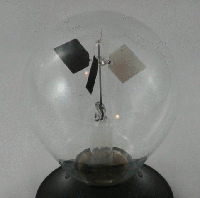Radiation pressure

Radiation pressure is the pressure exerted upon any surface exposed to electromagnetic radiation. If absorbed, the pressure is the energy flux density divided by the speed of light. If the radiation is totally reflected, the radiation pressure is doubled. This happens because the waves that make up electromagnetic radiation carry momentum with them and pass that momentum on when they reach a surface.
A Crookes radiometer appears to demonstrate the pressure of light, but instead it demonstrate the energy that light brings to a surface. The black side of each paddle absorbs most of the light's energy an causes the air near that surface to have a higher pressure. So, while a Crookes radiometer turns because of pressure, it is air pressure caused by the heat energy that light brings to the device.
Solar radiation at Earth[change | change source]
The solar radiation at Earth's distance from the Sun has an energy flux density of 1370 W/m2, and more than half of this energy reaches surface. A calculation shows that this value of the flux would cause on an absorbing surface to experience 4.6 µPa of radiation pressure. A convenient way to compare the Sun's energy flux and radiation pressure is to imagine the pressure and energy deposited on one square meter:
- Power = (or about 1.4 kilowatts.)
- Force =
To understand how small a micro-newton is, convert calculate how much mass you need on Earth to get that force using :
- Mass = (or about ½ milligram.)
The difference between the energy flux and the pressure is like the difference between the heat coming through a large window and the weight of a very small mosquito.[1]
References[change | change source]
- ↑ "List of Common Things That Weigh a Milligram". 23 February 2020.
Further reading[change | change source]
- Demir, Dilek,"A table-top demonstration of radiation pressure",2011, Diplomathesis, E-Theses univie (http://othes.univie.ac.at/16381/)




